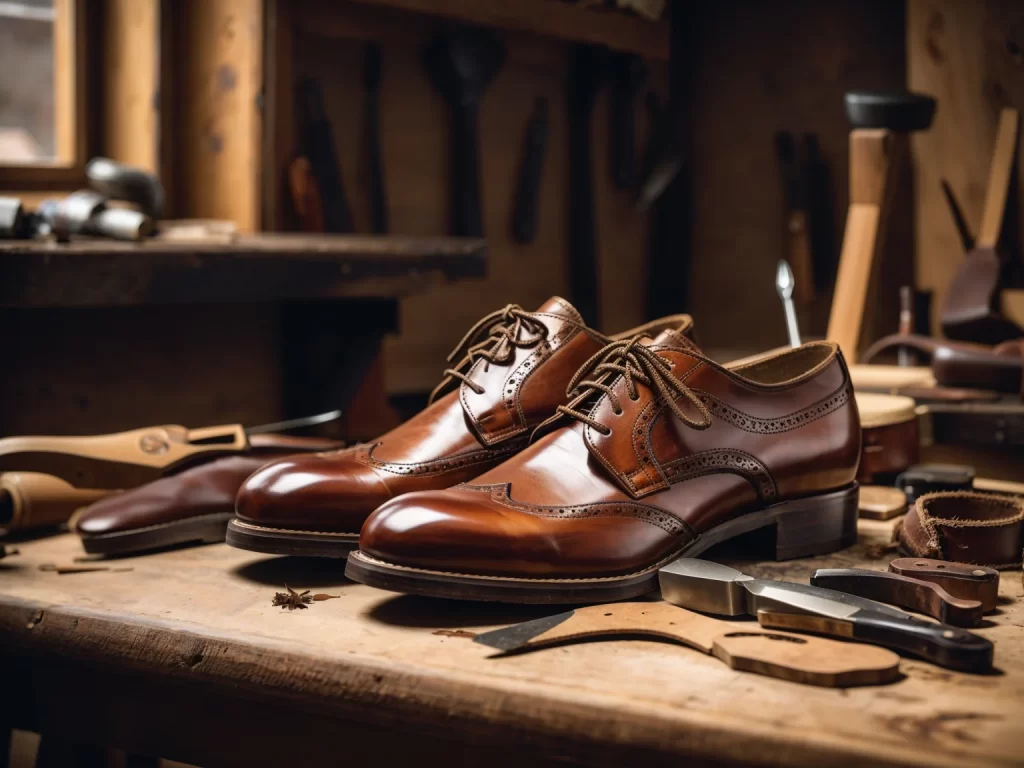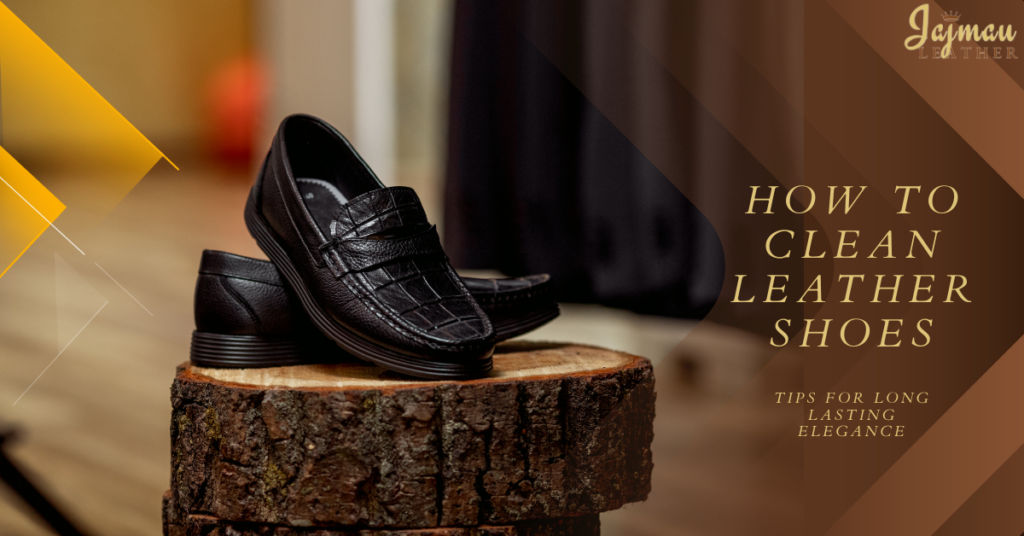Leather shoes are known for their durability and timeless appeal, but keeping them looking their best requires more than just occasional cleaning. Knowing how to clean leather shoes properly is essential, as leather is a natural material that can dry out, crack, and lose its shine over time without the right care.

In this guide, we’ll walk you through practical, easy steps to clean leather shoes and help preserve their quality and beauty for years to come.
Essential Tools and Materials for Cleaning Leather Shoes
To clean your leather shoes effectively, you will need:
- Soft brush or cloth
- Mild soap or leather cleaner
- Water
- Leather conditioner
- Shoe polish (optional)
- Shoe brush
- Microfiber cloth
- Shoe trees (optional)
- Waterproofing spray (optional)
Step-by-Step Guide On How To Clean Leather Shoes

Step 1: Remove Loose Dirt and Debris
Begin by removing any loose dirt or debris from your leather shoes. Use a soft brush or cloth to wipe down the surface of the shoes gently. Pay special attention to the soles and crevices where dirt can accumulate. Regularly removing surface dirt prevents it from embedding into the leather, which can cause scratches and wear over time.
Step 2: Prepare the Cleaning Solution
Mix a small amount of mild soap (like dish soap or baby shampoo) with lukewarm water for a homemade cleaning solution. Alternatively, you can use a commercial leather cleaner. Always follow the instructions on the product label. Harsh detergents can strip the leather of natural oils, leading to dryness and cracking.
Step 3: Clean the Leather
Dampen a cloth with the cleaning solution and gently wipe down the surface of the shoes. Focus on any dirty or stained areas, using more pressure as needed. Avoid soaking the leather, as excessive moisture can damage it. Be sure to clean the entire shoe, including the seams and edges. Leather is a porous material, so it’s important to clean it gently to avoid pushing dirt further into the pores.
Step 4: Rinse and Dry
After cleaning, dampen another cloth with plain water and wipe away any soap residue. This step is crucial to prevent the soap from drying out the leather. Use a dry microfiber cloth to blot the shoes and remove excess moisture. Allow the boots to air dry naturally in a well-ventilated area, away from direct sunlight or heat sources. Rapid drying can cause the leather to become stiff and brittle.
Step 5: Condition the Leather
Leather can lose its natural oils over time, making it prone to drying and cracking. To keep it supple and hydrated:
- Apply a leather conditioner.
- Use a small amount of conditioner on a clean cloth and rub it into the leather in circular motions.
- Allow the conditioner to absorb fully, usually 15-20 minutes.
- Wipe off any excess conditioner with a dry cloth.
Conditioning your leather shoes regularly will keep them soft and pliable.
Step 6: Polish the Shoes (Optional)
Polishing your leather shoes can enhance their shine and provide extra protection. Choose a shoe polish that matches the color of your shoes. Apply a small polish with a soft cloth or applicator brush, using circular motions to work it into the leather. Allow the polish to dry, then buff the shoes with a shoe brush or microfiber cloth to achieve a shine. Polishing improves appearance and adds a protective layer against moisture and dirt.
Step 7: Protect with Waterproofing (Optional)
Consider applying a waterproofing spray to protect your leather shoes from water damage and stains. Follow the instructions on the spray can for the best results. This step is especially useful if you plan to wear your shoes in wet or snowy conditions. Waterproofing can help prevent water from seeping into the leather, which can cause stains and damage.
Also Read : How to Clean Leather Couch? | The Ultimate Guide

Specialized Stain Removal Techniques
Ink Stains
- Rubbing Alcohol: Dip a cotton swab in rubbing alcohol and gently dab the ink stain. Avoid rubbing hard, as this can spread the stain. Wipe with a clean cloth and let it dry naturally. Ink stains can be particularly stubborn, so treating them as soon as possible is important.
Water Stains
- Blotting: Blot the excess water with a dry cloth if your shoes get wet. Allow the boots to air dry naturally, away from direct heat sources. Rapid drying can cause the leather to stiffen and crack.
Salt Stains
- Vinegar Solution: Mix equal parts water and white vinegar. Dampen a cloth with the solution and gently wipe the salt-stained areas. Wipe with a damp cloth and allow the shoes to air dry. Salt stains, common in winter, can damage the leather if not treated promptly.
Additional Tips for Leather Shoe Care | How to Clean Leather Shoes
- Regular Maintenance: Clean your leather shoes regularly to prevent dirt and grime from building up. A quick wipe-down after each wear can go a long way in maintaining their appearance.
- Use Shoe Trees: Insert shoe trees into your leather shoes when not in use to help them retain their shape and absorb moisture.
- Rotate Shoes: Avoid wearing the same pair of leather shoes every day. Give them time to air out and recover their shape by rotating between pairs.
- Store Properly: Store your leather shoes in a cool, dry place. Use dust bags or shoe boxes to protect them from dust and scratches.
- Handle with Clean Hands: Oils and dirt from your hands can transfer to the leather, causing stains. Handle your shoes with clean hands to keep them looking fresh.
- Avoid Direct Heat: Never dry your leather shoes near a direct heat source, such as a radiator or heater, which can cause the leather to crack.

Understanding Different Types of Leather Shoes
Different types of leather shoes may require slightly different care. Here’s a brief overview:
- Full-Grain Leather: The highest quality, full-grain leather shoes are durable and develop a beautiful patina over time. They require regular conditioning and occasional polishing.
- Top-Grain Leather: Slightly less durable than full-grain, top-grain leather shoes are more resistant to stains but still benefit from regular conditioning and polishing.
- Patent Leather: Known for its glossy finish, patent leather requires special cleaners and should be kept away from abrasive materials.
- Suede and Nubuck: These types of leather have a soft, velvety texture and require specific care products like suede brushes and erasers to maintain their appearance.
Discover more: How to Clean Leather Boots | Cleaning and Maintenance Tips
FAQs | How to Clean Leather Shoes
Q.1 What is the best way to clean leather shoes?
The best way to clean leather shoes is by using a soft cloth to wipe off dirt. For stains, use a mild soap and water mixture or a special leather cleaner.
Q.2 Can I wash leather shoes with water?
It’s best not to wash leather shoes directly with water, as too much moisture can damage the leather. Instead, wipe them gently with a damp cloth.
Q.3 How do you clean 100% genuine leather?
To clean 100% genuine leather, use a soft cloth and a leather cleaner or a mixture of mild soap and water. Always dry the leather with a clean towel afterward.
Q.4 Is baking soda safe for leather?
Baking soda can be used to remove odors from leather, but it should be used in small amounts and gently. Avoid scrubbing, as it can damage the surface.
Q.5 Is coconut oil good for leather?
Coconut oil can be used to soften leather and restore shine, but it should be used sparingly. Too much oil can make the leather too greasy.
Q.6 Can I use Vaseline on leather?
Vaseline should be used very carefully on leather. It can make the leather soft, but it may also leave greasy stains, so it’s best to test it in a hidden spot first.
Q.7 What oil is best for leather?
The best oils for leather are natural oils like mink oil or olive oil. These help keep leather soft without making it too greasy.
Q.8 What not to use on leather?
Avoid using harsh chemicals, bleach, or alcohol on leather. These can cause the material to dry out, crack, or lose its color.
Conclusion | How to Clean Leather Shoes
In conclusion, understanding how to clean leather shoes properly is key to preserving their style and quality. By following simple cleaning, conditioning, and polishing steps, you can maintain your leather shoes in great condition for years to come.

Regular care will not only keep them looking stylish but also ensure they remain a long-lasting and comfortable part of your wardrobe. With the right attention, your leather shoes will continue to provide both elegance and durability for every step you take.
Read more: How to Clean Leather Purse | The Secret to a Gorgeous Leather Purse

